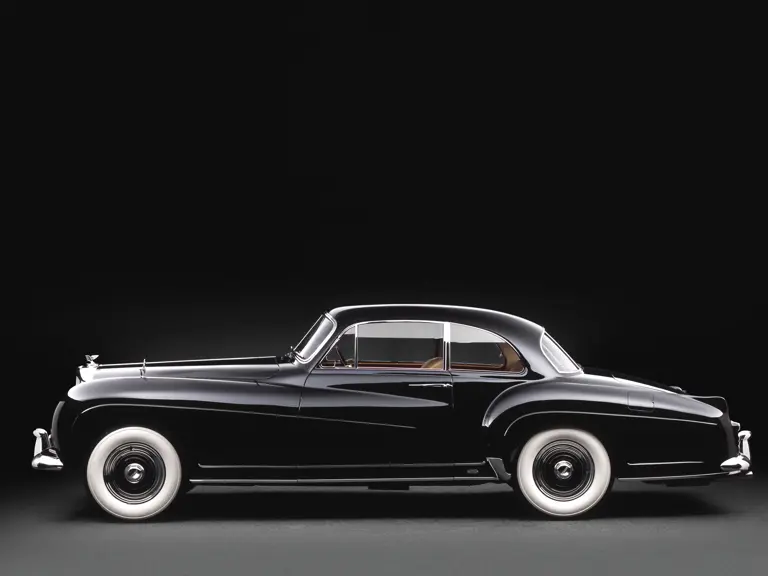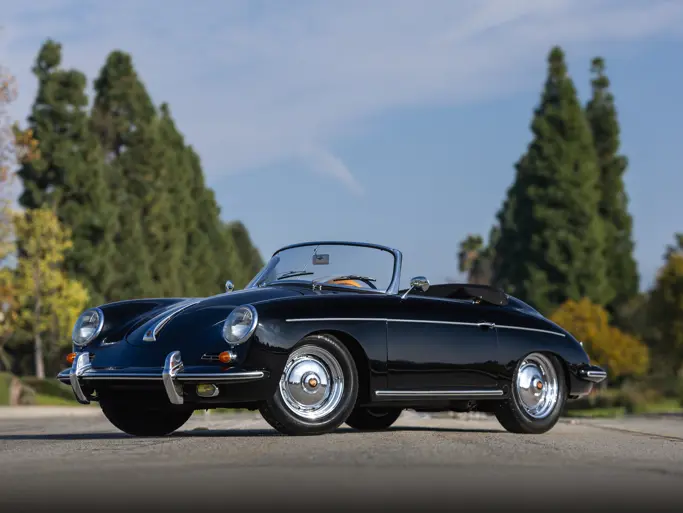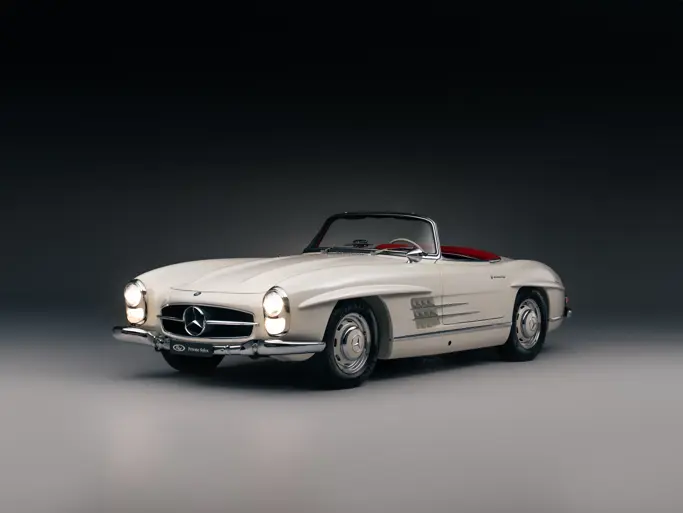155 bhp, 4,887 cc inlet-over-exhaust inline six-cylinder engine, four-speed automatic gearbox, coil spring independent front suspension, live rear axle with semi-elliptic leaf springs, and four-wheel servo-assisted hydraulic drum brakes. Wheelbase: 3,048 mm (120")
- The last R-Type Continental built
- Ex-Paris Salon l’Automobile 1955
- One of only 208 R-Type Continentals and just five Franay-bodied examples
- One-off coachwork; the last designed by Marius Franay
- Rare left-hand drive car and one of only nine with automatic gearbox
- Restored to original specification, shown at Villa d’Este in 2003
- The fastest production four-seater in the world
No post-World War II Bentley has acquired such cachet as the R-Type Continental. Two-door touring coupés intended for high-speed touring, most R-Type Continentals were bodied as fastback sports saloons by H.J. Mulliner. A few, however, were shipped abroad to be clothed by Continental coachbuilders, in this case the venerable French carrosserie Franay.
As early as 1950, Rolls-Royce management had recognised the desirability of a more sporting Bentley, more akin to the “silent sports car” Bentley of the 1930s. From this was born a prototype designated “Corniche II” by the design department but nicknamed “Olga” for its registration number: OLG490. Chief engineer Ivan Evernden was restricted in the basic chassis details, so in order to improve performance, he pursued reductions in weight and frontal area and looked to tall gearing and close gearbox ratios for high cruising speeds. Engine modifications were confined to carburetion and manifolding. The four-seat, two-door fastback body was drawn by Rolls-Royce stylist J.P. Blatchley and executed in aluminium by London coachbuilder H.J. Mulliner, long a Rolls-Royce clothier.
Mulliner’s careful craftsmanship shaved 225 kg (500 lbs) off the standard Bentley, and high-speed tests at Montlhéry in September 1951 yielded the desired 192 km/h (two miles per minute). It was, as its makers boasted, the fastest production four seater in the world.
The R-Type Continental, as it was christened, was produced from 1952 to 1955. There were five series of R-Type Continental, suffixed A through E. A larger, "Big Bore" 4.9-litre six-cylinder engine heralded the D series in May 1954, and a four-speed automatic gearbox became optional part way through the C series.
In all, 208 Bentley R-Type Continentals (including the works prototype "Olga") were built. Of these, 192 were bodied by H.J. Mulliner in a style nearly identical to the "Olga" prototype, six were bodied by Park Ward, three by Graber in Switzerland and a single example by Pinin Farina. Five, including the car offered here, were bodied in France by Franay.
Franay
Carrosserie Franay was established by Jean-Baptiste Franay at Levallois-Perret, a Paris suburb, in 1903. Franay’s son, Marius, joined the company after leaving school and took over management in 1922. By 1913 Franay’s work began to come into its own, reaching its zenith from 1927 to 1937, when it appeared most frequently on the chassis of Hispano-Suiza, Packard and Duesenberg. In the late 1930s, he began close ties with Delahaye and bodied a few Rolls-Royce and Bentley chassis as well.
After World War II, all European coachbuilders faced new challenges. The burgeoning use of unibody construction all but ruled out coachbuilding on inexpensive marques, and the French, in particular, had to contend with government policies that dealt luxury manufacturers severe handicaps. Franay was thus constrained to dwindling work, mainly for Delage and Delahaye, with the occasional commission from abroad. Post-war Franay-bodied cars are therefore extremely rare.
Chassis BC.9.LE.
Of the five Bentley Continentals bodied by Franay, three were to the Mulliner fastback saloon pattern, with British panels accompanying the chassis on their journeys to France. One was a right-hand drive coupé of Franay’s own design. This particular car, BC.9.LE., was the last designed personally by Marius Franay, a one-off design with unique, two-door aluminium coupé coachwork with elegant tail fins. Just 43 Continentals had left-hand drive, and only nine of those featured the automatic gearbox, so this car was in select company.
BC.9.LE., the last Continental chassis to be completed, was ordered by a Monsieur Choumert of Paris and invoiced to Franco-Britannic Automobiles, Ltd., the French distributor, on 17th January, 1955. Built with left-hand drive and the enlarged 4.9-litre six-cylinder engine, it was shipped to France aboard S.S. Deal on 4th February, sailing from Folkestone to Boulogne. As supplied, it featured optional four-speed automatic gearbox, coil spring independent front suspension, live rear axle with semi-elliptic leaf springs, four-wheel servo-assisted hydraulic drum brakes, a dashboard heater, flashing turn indicators, metric speedometer, Wilmot-Breedon Continental bumpers, French-type Marchal headlamps, fog-lamps, four high-frequency horns, reversing lamps and a flat petrol tank. A set of front floorboards, complete with nuts and bolts, was included with the chassis. A driver from Franco-Britannic Automobiles reportedly met the ship at Boulogne and drove the chassis, seated on a box, to Franay’s premises in Levallois-Perret.
Franay proceeded to construct the handsome aluminium fixed-head coupé body painted in silver grey. Trimmed in beige leather, the way it is presented today, and with Englebert wide whitewall tyres, it was equipped with lightweight seats supplied by H.J. Mulliner and weighed 1,762 kg (3,877 lbs) on completion. Franay delivered the completed car to M. Choumert on 28th May, 1955. The car graced the Franay display at the 1955 Paris Salon, held at the Grand Palais that October.
M. Choumert traded the car back to Franco-Britannic Automobiles in January 1960, and it was sold to another Frenchman, M. Labaden. In 1965, it was again sold through Franco-Britannic Automobiles to a M. Sarntier before being exported in January 1969 to the United States for new owner, Arthur Wagman, a Maryland attorney. Wagman kept the car for a very long time, up until 1990 in fact, at which point it was sold to B.D. Cooney, also in the USA. The present owner, a German collector, purchased it fully restored in June 1999.
Since that time, the car has participated in the 2003 Concorso d’Eleganza Villa d’Este before winning its class the following year at the fourth annual European Concours d’Elegance in Düsseldorf, Germany.
Finished entirely in black, the car exhibits a deep shine. The brightwork is tasteful and brief, a simple rocker panel moulding meeting a bright stone-guard on the rear wing. The other body highlights are provided by crease lines in the panels themselves, boldly contrasted by wide whitewall tyres. The interior is done in attractive beige leather with matching carpets. The dashboard and interior woodwork are polished to a high-gloss finish, and the engine compartment is clean and correctly detailed.
A unique and especially desirable R-Type Bentley Continental, this car comes with a documented history from Bentley Motors, its original handbook, a FIVA passport and a complete tool set. In addition, it still has the original French number plate assigned to its first owner. With the large 4.9-litre engine and optional automatic gearbox, it is ideally equipped for future concours events and certainly gran turismo motoring, for which it was intended.
155 cv, motore 6 cilindri in linea di 4.887 cc con valvole di aspirazione in testa e scarico laterali, cambio automatico a quattro rapporti, sospensione anteriore a ruote indipendenti con ammortizzatori a molla, assale posteriore rigido con balestre semi-ellittiche, freni a tamburi idraulici con servofreno. Passo: 3.048 mm
- L'ultima R-Type Continental costruita
- Presentata al Salone dell’Automobile di Parigi del 1955
- Una delle sole 208 R-Type Continental e delle cinque carrozzate da Franay
- Esemplare unico; l'ultima carrozzeria disegnata da Marius Franay
- Raro esemplare con guida a sinistra e una delle sole nove vetture con cambio automatico
- Restaurata con le specifiche originali, presentata a Villa d'Este nel 2003
- La quattro posti di serie più veloce del mondo
Nessuna Bentley del secondo dopo-guerra ha goduto di tanto prestigio quanto la R-Type Continental. Coupé granturismo due porte ad alte prestazioni, le R-Type Continental furono costruite nella maggioranza con carrozzeria coupé 2 volumi da H.J. Mulliner. Sole poche, quindi, furono spedite all'estero per essere vestite da carrozzieri del continente, in questo caso dalla famosa carrozzeria francese Franay.
Nel 1950 la direzione della Rolls-Royce aveva compreso quanto fosse desiderata una Bentley più sportiva, più vicina allo spirito delle "silent sports car" degli anni Trenta. Era quindi stato sviluppato un prototipo, denominato "Corniche II” dal centro stile, ma soprannominato “Olga” per la sua targa: OLG490. Il capo progettista Ivan Evernden era vincolato nelle scelte di base per il telaio e quindi, al fine di aumentare le prestazioni, cercò di ridurre il peso e l'area frontale, e di allungare i rapporti al ponte e montare rapporti al cambio più ravvicinati per una maggiore velocità di crociera. Le modifiche al motore si limitarono ai carburatori e ai collettori. La carrozzeria coupé due volumi due porte con quattro posti fu disegnata dallo stilista della Rolls-Royce J.P. Blatchley e fu costruita, in alluminio, dalla carrozzeria H.J. Mulliner di Londra, da tempo la preferita dalla Rolls-Royce.
Le accurate lavorazioni di Mulliner permisero di diminuire il peso di 225 kg rispetto alla Bentley di serie e durante le prove di velocità sul circuito di Montlhéry nel settembre 1951 la vettura raggiunse i desiderati 192 km/h (ovvero le due miglia al minuto). Era, come venne pubblicizzato, la vettura di serie a quattro posti più veloce del mondo.
Denominata R-Type Continental, la vettura fu prodotta dal 1952 al 1955 in cinque serie, distinguibili dal suffisso da A a E. La cilindrata del motore 6 cilindri fu portata a 4,9 litri con la serie D nel maggio del 1954, mentre il cambio automatico a quattro rapporti era già stato reso disponibile a richiesta con la serie C.
In tutto, furono costruite 208 Bentley R-Type Continental (compreso il prototipo "Olga"). Di queste ben 192 furono carrozzate da H.J. Mulliner in uno stile praticamente identico a quello di "Olga", sei da Park Ward, tre da Graber in Svizzera e una da Pinin Farina. Cinque, compresa questa offerta, furono carrozzate in Francia da Franay.
Franay
La Carrosserie Franay fu fondata nel 1903 da Jean-Baptiste Franay a Levallois-Perret, un sobborgo di Parigi. Il figlio di Franay, Marius, entrò nella ditta dopo aver finito gli studi, assumendone la direzione nel 1922. A partire dal 1913, Franay cominciò ad avere un proprio stile, raggiungendo l'apice del successo fra il 1927 e il 1937, carrozzando sempre più frequentemente telai Hispano-Suiza, Packard e Duesenberg. Alla fine degli anni Trenta, strinse stretti legami con la Delahaye e carrozzò anche telai Rolls-Royce e Bentley.
Dopo la seconda guerra mondiale, tutti i carrozzieri europei furono messi di fronte a una nuova sfida. La diffusione della scocca portante aveva ridotto per tutti la possibilità di carrozzare le vetture di basso costo e i carrozzieri francesi, in particolare, si scontravano con la politica fiscale del governo che penalizzava i produttori di vetture di lusso. Franay vide quindi diminuire il lavoro per Delage e Delahaye, ricevendo solo saltuarie commissioni da marche straniere: ecco perchè le carrozzerie di Franay del dopo-guerra sono estremamente rare.
Il telaio BC.9.LE
Delle cinque Bentley Continental carrozzate da Franay, tre furono eseguite sui disegni del coupé fastback di Mulliner su telai spediti in Francia già dotati di pannelli costruiti in Inghilterra. Una fu una coupé con guida a destra disegnata da Franay e questa offerta, telaio BC.9.LE, è stata l'ultima vettura disegnata personalmente da Marius Franay, un esemplare unico con carrozzeria a due porte in alluminio con eleganti pinne posteriori. Solo 43 Continental furono costruite con guida a sinistra, e solo nove di queste avevano il cambio automatico; questa vettura fa quindi parte di un ben ristretto gruppo.
BC.9.LE, ultimo telaio Continental completato, fu ordinato da un certo Choumert di Parigi e fatturato il 17 gennaio 1955 alla Franco-Britannic Automobiles, Ltd., il distributore francese. Costruito con guida a sinistra e dotato del motore 6 cilindri portato a 4,9 litri, fu stivato il 4 febbraio sulla motonave S.S. Deal, che salpava da Folkestone per Boulogne, in Francia. Il telaio era dotato di cambio automatico a quattro rapporti, sospensione anteriore a ruote indipendenti con ammortizzatori a molla, assale posteriore rigido con balestre semi-ellittiche, freni a tamburo sulle quattro ruote con servofreno, impianto di riscaldamento sul cruscotto, frecce di direzione, tachimetro in chilometri, paraurti Wilmot-Breedon Continental, fari Marchal di tipo francese, antinebbia, quattro trombe ad alta frequenza, fari di retromarcia e serbatoio piatto. Fu incluso anche un set di pianali anteriori, completo di dadi e bulloni. Un autista della Franco-Britannic Automobiles raggiunse la nave a Boulogne e guidò l'autotelaio fino alla fabbrica di Franay a Levallois-Perret, seduto su una cassetta di legno.
Franay costruì la sua bella carrozzeria coupé in alluminio, la verniciò in grigio-argento, la tappezzò in pelle beige, com'é oggi, montò pneumatici a fascia bianca Englebert e fissò i leggeri sedili forniti da Mulliner: il peso totale della vettura risultò di 1.762 kg. La Bentley fu consegnata al sig. Choumert il 28 maggio 1955, ma nell'ottobre di quello stesso anno fu esposta nello stand di Franay al Salone dell'Automobile di Parigi, al Grand Palais.
Nel gennaio 1960 Choumert permutò la vettura presso la Franco-Britannic Automobiles, che la rivendette a sua volta ad un altro francese, il sig. Labaden. Nel 1965, la vettura fu acquistata, sempre tramite la Franco-Britannic Automobiles, da un certo Sarntier e fu quindi esportata nel gennaio 1969 negli Stati Uniti per il suo nuovo proprietario, Arthur Wagman, un avvocato del Maryland. Wagman la tenne per molto tempo, per la precisione fino al 1990, quando la vendette a un altro americano, B.D. Cooney. L'attuale proprietario tedesco l'acquistò, già completamente restaurata, nel giugno 1999.
Da allora, la vettura ha partecipato nel 2003 al Concorso d'Eleganza di Villa d'Este e ha vinto l'anno seguente la classe alla quarta edizione del Concorso d'Eleganza di Düsseldorf, in Germania.
Finita completamente in nero, la vettura esibisce una splendente verniciatura; le cromature sono raffinate e discrete, una semplice modanatura ricurva che si esaurisce con il parasassi sul parafango posteriore. Molto particolari sono le nervature dei pannelli, efficacemente evidenziate dai pneumatici a fascia bianca. La tappezzeria è in pelle beige con tappetini in tinta; il cruscotto e i particolari in legno degli interni sono ben lucidati e il vano motore è pulito e ben tenuto.
Esclusiva e desiderabile, questa Bentley R-Type Continental è ben corredata da un dossier storico della Bentley Motors, dal libretto uso e manutenzione originale, dal passaporto FIVA e da un completo set di attrezzi. Inoltre, ha ancora la targa originale francese assegnata al suo primo proprietario. Grazie al generoso motore di 4,9 litri e al cambio automatico, è sicuramente adatta per partecipare a qualsiasi concorso ma soprattutto ad essere utilizzata in lunghi viaggi gran turismo, per i quali fu progettata.



 | Cernobbio, Italy
| Cernobbio, Italy


